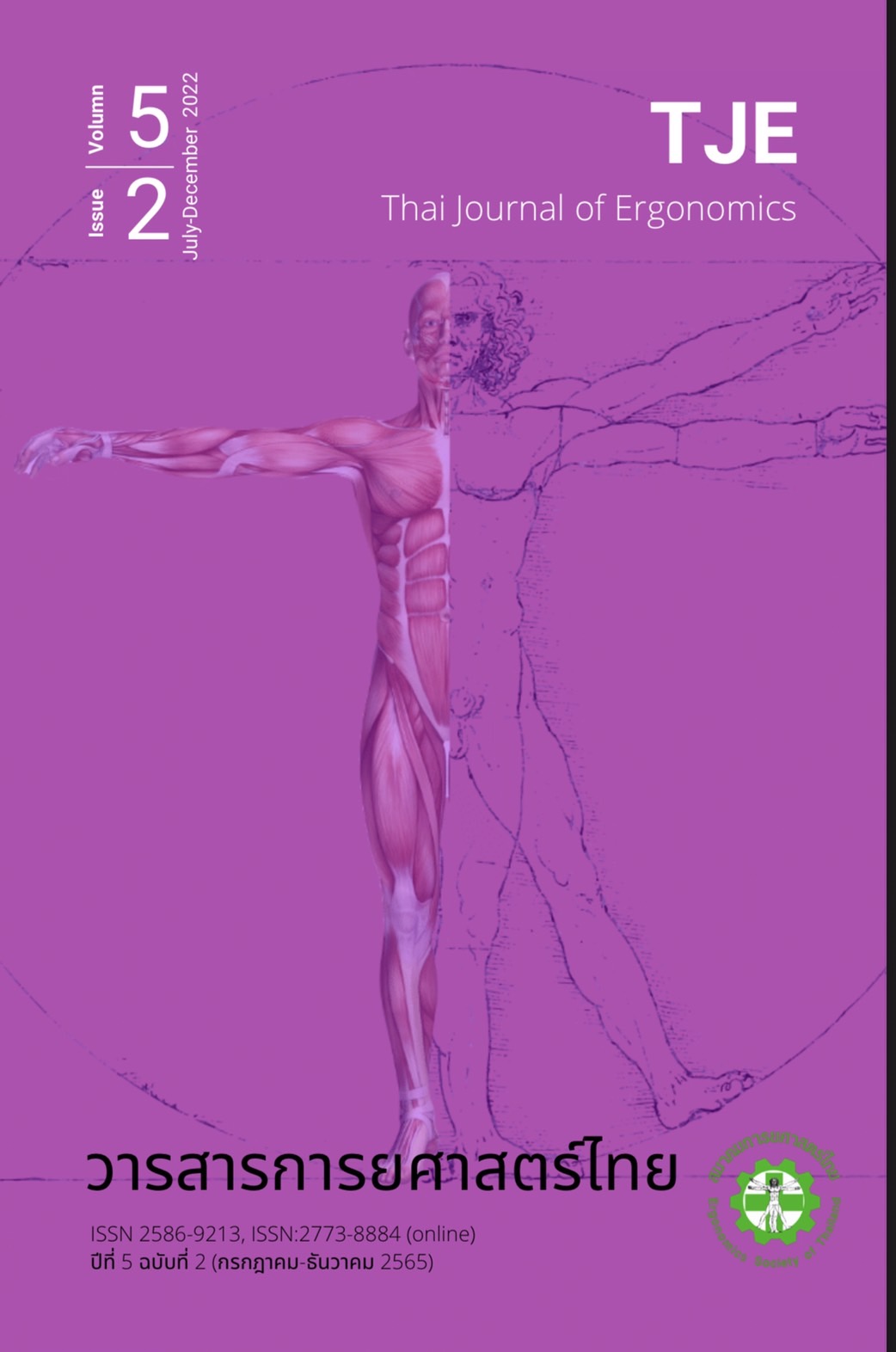The study of smartphone usage duration and direction of visual stimulation on response time
Main Article Content
Abstract
Nowadays, the smartphone is an indispensable part of everyday life. Smartphone usage can distract awareness ability increasing response time. A quick response time allows us to respond to a stimulus quickly and efficiently. Therefore, using a smartphone at any time may result in decreasing carefulness and may cause danger. This study determined the effect of usage duration and direction of visual stimulation on response time during using a smartphone. 32 healthy female participants aged 18-24 years were recruited. Response time was measured while not using a smartphone and while using a smartphone by reading text or watching videos without sound. The red plain screen showed up randomly at 30, 120, and 300 seconds and from the front, left, and right while subjects were using the smartphone. The response time when using a smartphone was significantly slower than when not using a smartphone (p<0.01) but there was no significant difference in the duration of smartphone usage. Moreover, the result showed the response time was not different between the front, left, and right sides of visual stimuli. It was concluded that using a smartphone can divert attention away from the environment, increasing response time in all direction of stimuli.
Article Details

This work is licensed under a Creative Commons Attribution-NonCommercial-NoDerivatives 4.0 International License.
References
จิรเดช อย่าเสียสัตย์. ผลการฝึกความสัมพันธ์ของระบบประสาทกล้ามเนื้อและเวลาตอบสนองที่มีต่อเวลาปฏิกิริยาและเวลาในการเคลื่อนไหว [วิทยานิพนธ์ปริญญาวิทยาศาสตรมหาบัณฑิต]. กรุงเทพฯ: มหาวิทยาลัยศรีนครินทรวิโรฒ; 2551.
เพ็ญจันทร์ ศรีสุขสวัสดิ์, เอนก สูตรมงคล. เวลาปฏิกิริยาของบุคคลในแต่ละช่วงอายุทั้งชายและหญิง: วารสารศึกษาศาสตร์ มหาวิทยาลัยบูรพา. 2546;15:57–72.
Balasubramaniam M, Sivapalan K, Nishanthi V, Kinthusa S, Dilani M. Effect of dual-tasking on visual and auditory simple reaction times. Indian J Physiol Phamacol. 2015;59:194–8.
Watcharakarn A. การใช้เทคโนโลยีส่งผลกระทบต่อการดำเนินชีวิตของวัยรุ่นอย่างไร [อินเทอร์เน็ต]. 2012 [เข้าถึงเมื่อ 22 ก.ย. 65]. เข้าถึงได้จาก: https://www.gotoknow.org/posts/410843
สำนักงานพัฒนาธุรกรรมทางอิเล็กทรอนิกส์ กระทรวงดิจิทัลเพื่อเศรษฐกิจและสังคม. Thailand internet user behaviour 2022 [อินเทอร์เน็ต]. 2022 [เข้าถึงเมื่อ 10 พ.ย. 2565]. เข้าถึงได้จาก: https://www.etda.or.th/th/Useful-Resource/publications/iub2022.aspx.
ไอที 24 ชั่วโมง. ผลสำรวจพฤติกรรมผู้ใช้งานอินเทอร์เน็ตในไทย ปี 58 เผยคนไทยออนไลน์ผ่านมือถือทุกช่วงเวลา [อินเทอร์เน็ต]. 2015 [เข้าถึงเมื่อ 22 ก.ย. 2565]. เข้าถึงได้จาก: https://www.it24hrs.com/2015/thailand-internet-user-profile-2015-2558/
Abbas M. The effect of cell phone conversation and texting on reaction time and vehicle accidents. British Journal of Arts and Social Sciences. 2012;11(1): 109–25.
Bellinger DB, Budde BM, Machida M, Richardson GB, Berg WP. The effect of cellular telephone conversation and music listening on response time in braking. Trans Res F: Traffic Psychol Behav. 2009;12(6):441-51.
Consiglio W, Driscoll P, Witte M, Berg WP. Effect of cellular telephone conversations and other potential interference on reaction time in a braking response. Accid Anal Prev. 2003;35(4):495–500.
Maples WC, DeRosier W, Hoenes R, Bendure R, Moore S. The effects of cell phone use on peripheral vision. Optometry. 2008;79(1):36–42.
Al-Darrab IA, Khan ZA, Ishrat SI. An experimental study on the effect of mobile phone conversation on drivers' reaction time in braking response. J Safety Res. 2009;40(3):185-9.
Kim E, Kim H, Kwon Y, Choi S, Shin G. Performance of ground-level signal detection when using a phone while walking. Accid Anal Prev. 2021;151:1-6.
Caird JK, Johnston KA, Willness CR, Asbridge M, Steel P. A meta-analysis of the effects of texting on driving. Accid Anal Prev. 2014;71:311–8.
Strayer DL, Drews F, Johnston WA. Cell phone-induced failures of visual attention during simulated driving. J Exp Psychol Appl. 2003;9(1):23–32.
จุฬารักษ์ กวีวิวิธชัย, ภิญโญ พานิชพันธ์, พิณทิพ รื่นวงษา, เจริญศรี ธนบุญสมบัติ. การมองเห็น [อินเทอร์เน็ต]. 2017 [เข้าถึงเมื่อ 22 ก.ย. 2565]. เข้าถึงได้จาก:
https://il.mahidol.ac.th/e-media/nervous/ch3/index.htm
McLeod S. Theories of selective attention. [Internet]. 2018 [cite 2022 Sep 22]. Available from: https://www.simplypsychology.org/attention-models.html
Lee S, Kang H, Shin G. Head flexion angle while using a smartphone. Ergonomics. 2015;58(2):220-6.
Wang B, Guo J, Yan T, Ohno S, Kanazawa S, Huang Q, et al. Neural response to central and peripheral objects in the lateral occipital cortex. Front Hum Neurosci. 2016;10:1-11.
Yoon W, Choi S, Han H, Shin G. Neck muscular load when using a smartphone while sitting, standing, and walking. Hum Factors. 2021;63(5):868-79.
Han H, Shin G. Head flexion angle when web-browsing and texting using a smartphone
while walking. Appl Ergon. 2019;81:1-4.
Ghisletta P, Renauad O, Fagot D, Lecerf T, Ribaupierre A. Age and sex differences in intra-individual variability in a simple reaction time task. Int J Behav Dev. 2018;42(2):294-9.


